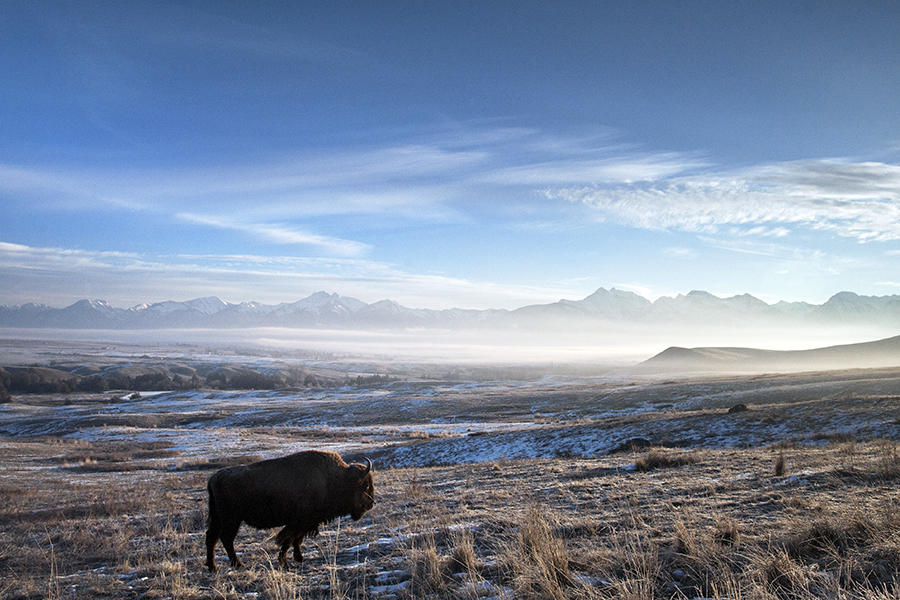There’s a prominent bluff-top perch on the Flathead Indian Reservation overlooking an oxbow section of Mission Creek, above which rises the rolling features of Red Sleep Mountain and the National Bison Range.
In addition to the remarkable scenery, the view has historically offered a stark contrast — for more than a century those foothills upstream have belonged to the federal government, while the overlook and the expanse of wetland in the foreground sits on land belonging to the Confederated Salish and Kootenai Tribes (CSKT).
Much to the delight of tribal leaders, that jurisdictional gulf and the cultural juxtaposition it signified were repaired on Jan. 15, when U.S. Department of the Interior Secretary David L. Bernhardt signed an order directing the U.S. Fish and Wildlife Service (FWS) and the Bureau of Land Management (BLM) “to facilitate the transition of property related to the National Bison Range (NBR) to the Bureau of Indian Affairs (BIA)” and, by proxy, the CSKT.
“The CSKT have strong and deep historical, geographic and cultural ties to the land and the bison, and their environmental professionals have been leaders in natural resources and wildlife management for many decades,” Assistant Interior Secretary Tara Katuk Sweeney said in a prepared statement. “Interior is pleased to continue its partnership and work with them on the restoration of the NBR to federal trust ownership for the Tribes.”
The transfer was part of an omnibus spending bill signed by President Donald Trump on Dec. 27, 2020, and included as part of the Montana Water Rights Protection Act, co-sponsored by all three members of Montana’s congressional delegation. In addition to transferring the bison range, the act also settled a long-standing treaty negotiation that gave CSKT rights to major water resources inside the Flathead Indian Reservation in return for releasing claims on more than 10,000 water rights outside its boundaries.
Resolving the age-old conflict over water rights on the reservation signals a monumental accord, but the shift of the National Bison Range’s management responsibilities from the oversight of the federal government’s purview to the tribes’ marks an historic occasion. For the past 25 years, the tribes have been actively seeking to restore ownership of the 18,766 acres to a federal trust, which would allow the Salish and Kootenai to assume — or resume — full management responsibilities of the range.
In 1908, the tribes ceded control of the land against their will when the government established the National Bison Range in the Mission Valley, on a postage stamp of federal land right in the middle of the Flathead Indian Reservation. Returning management authority to the tribes — which required legislative action — has long been a primary objective for the CSKT, but negotiations have been stalled for over a quarter-century.
“The restoration of this land is a great historic event and we worked hard to reach this point. This comes after a century of being separated from the buffalo and the Bison Range, and after a quarter-century-long effort to co-manage the refuge with the FWS,” CSKT Chairwoman Shelly R. Fyant said. “And who better to do it than the original inhabitants of the land who depended on the buffalo for centuries? That was our mainstay.”
One of the reasons the transfer is so important to tribal members is because the CSKT’s Natural Resource Department has a robust record of innovative management, employing a stable of biologists who have worked to restore and protect complex habitat that supports everything from grizzly bears and bighorn sheep to leopard frogs and cattails. To deprive the tribes of their natural-born right to manage the bison range has long been seen as an affront, according to Rich Janssen, head of the CSKT’s Natural Resources Department.
“We are the top tribe in the nation for managing natural resources. We led the restoration efforts to bring this land back to its natural state,” he said. “You can see the National Bison Range from here, and yet we have not been leading that conservation conversation. We were not allowed to, even though the bison wouldn’t be here if it weren’t for us.”
Keith Aune, Bison Program Director for the Wildlife Conservation Society, has been a vocal supporter of CSKT’s efforts to restore management of the National Bison Range to a federal trust ownership, and says their record on the conservation of natural resources sets a high bar.
“What’s great about the Confederated Salish and Kootenai Tribes is that they have become a model of how you practice conservation on tribal lands not only within the boundaries of the reservation but even beyond,” Aune said.
